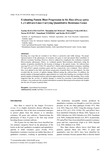Evaluating Panicle Blast Progression in Six Rice (Oryza sativa L.) Cultivars/Lines Carrying Quantitative Resistance Genes
Japan Agricultural Research Quarterly
| ISSN | 00213551 |
|---|---|
| NII recode ID (NCID) | AA0068709X |

Full text
jarq58-4_197-204.pdf1.09 MB
Breeding rice crops that are resistant to rice blast is a protective and viable strategy. The proper characterization of the phenotypes of resistance (R) genes to leaf and panicle blast contributes to effective resistance breeding. However, observer subjectivity complicates the evaluation of panicle blast-resistance phenotypes. Hence, we evaluated panicle blast-resistance phenotypes using the number of panicles classified by the location of damage to the panicle tissues. Six cultivars/lines carrying Pi35, pi21, Pi34, Pi39(t), Pb1, and qPbm11, which conferred quantitative resistance, including Pb1 and qPbm11, panicle resistance genes and loci, respectively, were evaluated. These cultivars/lines were planted in the field, and disease progression of panicle blast was investigated. Our data revealed that the severity of spikelet damage differed among the cultivars/lines. In addition, the panicle number of damaged spikelets approximately two weeks after heading was correlated with the panicle number of damaged rachises and necks approximately four weeks after heading. These results suggested that the severity of spikelet damage is crucial for assessing R gene-mediated panicle resistance. Our results provide essential information on panicle blast progression and provide insights into the role of R genes in panicle blast.
| Date of issued | |
|---|---|
| Creator | Yuriko HAYANO-SAITO Masahiko KUMAGAI Mitsuru NAKAMURA Tarou SUZUKI Tomofumi YOSHIDA Keiko HAYASHI |
| Subject | leaf blast Pyricularia oryzae |
| Publisher | Japan International Research Center for Agricultural Sciences |
| Received Date | 2023-10-12 |
| Accepted Date | 2024-01-10 |
| Available Online | |
| Volume | 58 |
| Issue | 4 |
| spage | 197 |
| epage | 204 |
| DOI | 10.6090/jarq.58.197 |
| Language | eng |
